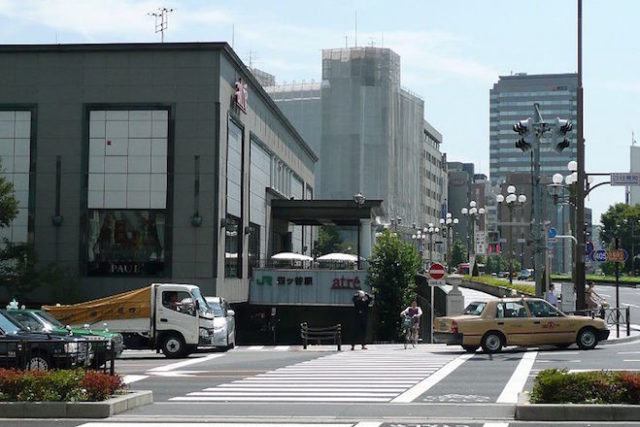By Yukiko Tanaka
The bus that goes along the Castle Moat, having gone through Tsukiji and Ginza, gets to Yotsuya Station at the line’s end. If you take JR’s Sobu Line instead, Yotsuya is the fourth station from Ochanomizu. The water of the Kanda River you see from the train disappears (goes underground) shortly af ter Iidabashi Station but reappears and stays in your view briefly only to disappear again before the train reaches Yotsuya Station.
Where the water originally was as a part of the Outer Moat is now raised ground, and this narrow stretch of hill, now Sotobori Park, was where the Edo Castle’s outer embankment once was. Shinjuku Ward stretches eastward from here but you should spend a bit of time exploring the area east of Yotsuya Station, the area, which is a part of Chiyoda Ward, you have yet to visit.
Nagatacho is Japan’s political center and at its north end, that is, immediately south of the area you are about to walk, is the subway station of Aakasaka- mitsuke, traffic around which is always very heavy. There were several mitsuke around Edo Castle, and one of these watch towers, Yotsuya-mitsuke, was where a bridge is now right by Yotsuya station. As the Edo Picture Map shows there were quite a few gates along the Outer Moat. The moat was filled later and made into today’s Sotobori-dōri, one of the main arteries in central Tokyo. During the Edo period there were many temples around where Yotsuya Station is, having been moved there to dig the Outer Moat. It was up to this area that was “the city of Edo”(verses suburbs or countryside areas).
That today’s Yotsuya was a part of “the city” in the Edo era can be seen in another way, that is, in the way water supply system the shogun’s government established. Water, having been brought f rom Musashino Plateau via a man-made Tamagawa-josui (still in use today!), went underground at Yotsuya to then be delivered throughout the city via stone or wooden pipes. You can see a part of those stone pipes displayed at the corner of Shimizudani Park in Kioi-chō, a neighborhood you are going to walk; its size, of course but the craftsmanship is quite impressive.
The Kioi-chō neighborhood of today was right inside the Outer Moat of the castle during the Edo era, the area where a few prominent domains in close relationship with the shogun, such as Kishu and Owari Domains, had their Edo residences. The name “Ki-o-i” thus is f rom these domains (“I” is f rom the Ii family explained below); there is a slope of the same name nearby as well. Along this slope were Kishu residences, which is where Hotel New Ohtani is now with its magnificent garden. A part of the Owari estate is now Shimizudani Park, and it was at this park, as I recall, that students’ political rallies in the late 1950s and early ‘60s held short meetings.
The estate of the Ii family was also nearby, and it was on his way to the Edo Castle that the head of the family (Hikone Domain) was assassinated by a group of samurai who objected his decision to open the country to a few western nations under pressure from the United States. It was soon after this incident that the shogun’s regime came to an end, ushering the nation to the new era of Meiji.
At the top of Kioi Slope is a wooden post that says: Chigai-mitsuke. A watchtower with a zigzag path to prevent the enemy’s advance was at this spot. Standing at this high point, you can see the wooded estate of Akasaka Detached Palace beyond the water of what was once the Outer Moat, now a pond with a bright red bridge over it. Not many people know but there is a boat rental shop by the water.
Exiting Yotsuya Station and standing on a broad street, Shinjuku-dōri, you will see a tower in a modern design, which belongs to Ignacio Catholic Church. Belonging to the Jesuits, the church is new and in a post-modern in style. Having taken many years to rebuild after the original was burned down during the Tokyo Fire Bombings (of World War II), it is now a fine church with a very simple interior. For some reason, I find more than a few Catholic churches in Tokyo with contemporary or postmodern designs (rather than in more traditional architecture) and the Church of Ignacio here is no exception.
Behind the church is Sophia University, a private institution in close association with the Ignacio Church. Among the university’s faculties are some priests. In fact, it was a priest who gave me an exam I took to obtain a US visa; as I recall, he made me write an essay (in English) on “how to solve traffic problems in Tokyo.” Sofia University has some foreign students as well as those returnees to Japan, a unique aspect of this institution.
The name of a street that goes by Sophia University campus and along Sotobori-dōri is named Sophia Street. It is a nice street to stroll on, but you should start your walk from Yotsuya Station along Sophia Street until the Kioi Hall, at which point you turn (left), on Kioi Slope. Proceed on the slope to the bottom where Simizudani Park is, peeping into the yard of Hotel Ohtani on the way. If you then walk all the way till Akasaka-mitsuke, it will take about half an hour. But it is a nice walk, indeed.
[Editor’s Note]
This series introduces a historical view of various sites in Tokyo. The writer can be reached at ytanaka03@gmail.com.







